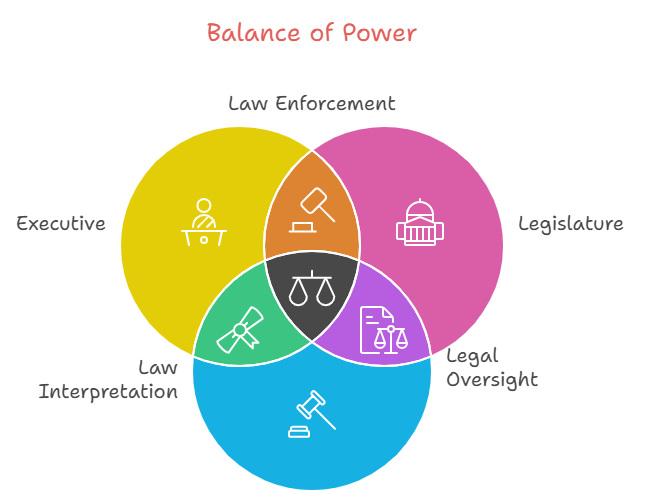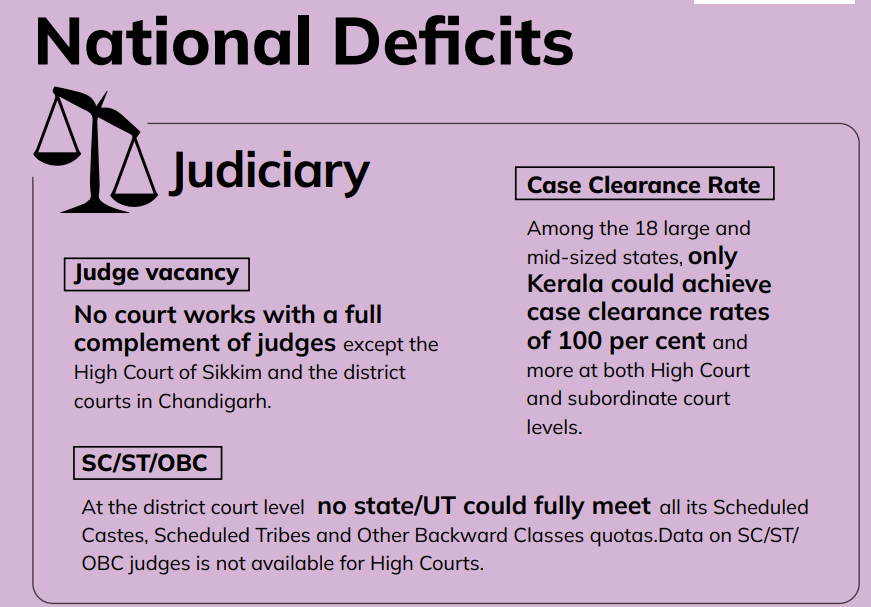Indian Polity
Judicial Independence and Accountability
- 01 Apr 2025
- 16 min read
This editorial is based on “Upendra Baxi writes: What does justice mean in Justice Varma case” which was published in The Indian Express on 31/03/2025. The article highlights that a recent judicial inquiry has sparked renewed debate on the balance between independence and accountability within the higher judiciary.
For Prelims: Indian Judiciary, Separation Of Powers, Supreme Court, High Courts, Judicial Review, Fundamental Rights, Restatement Of Values Of Judicial Life, Collegium System, National Judicial Appointment Commission (NJAC), Cases Pending, Judicial overreach, National Legal Services Authority’s (NALSA), National Mission for Justice Delivery, National eGovernance Plan, e-Courts Project, Handbook on Combating Gender Stereotypes.
For Mains: Significance of Independence and Accountability of the Indian Judiciary and Related Concerns.
The Indian judiciary faces renewed scrutiny amidst concerns over internal integrity and institutional transparency. A recent inquiry has prompted broader public engagement with the complex interplay between judicial independence and accountability. In this context, long-standing challenges, ranging from procedural opacity and case backlogs to the pressing need for inclusive reforms, have resurfaced, inviting thoughtful reflection on how to strengthen the judiciary's credibility and effectiveness in a constitutional democracy.
What Ensures Judicial Independence and Accountability in the Indian Constitution?
- Judiciary as a Separate Organ: The Constitution provides for a separation of powers among legislature, executive, and judiciary.
- Security of Tenure: Judges of the Supreme Court and High Courts enjoy security of tenure under Articles 124 and 217 respectively.
- This protects judges from arbitrary dismissal and promotes impartial decision-making.
- Fixed Service Conditions: Article 125 and Article 221 ensure non-variable salaries and service conditions of Supreme Court and High Court judges, safeguarding independence.
- All expenses of the Supreme Court are charged on the Consolidated Fund of India, protecting its financial autonomy from executive control.
- The salaries and expenses of High Court judges are charged on the state’s Consolidated Fund.
- While their pensions are drawn from the Consolidated Fund of India, making them non-votable but open to discussion.
- Removal Only by Impeachment: Articles 124(4) and 217(1)(b) permit removal only via parliamentary impeachment, not executive whim.
- This high threshold maintains judicial integrity and guards against politically motivated actions.
- Power of Judicial Review: Under Articles 32 and 226, courts enjoy judicial review powers to protect rights and uphold the Constitution.
- This empowers courts to act as guardians of fundamental rights and constitutional supremacy.
- No Discussion in Legislature: Article 121 restricts Parliament from discussing judicial conduct except during impeachment proceedings.
- This provision ensures that judges are insulated from legislative pressures.
- Contempt Powers: Article 129 and 215 empower courts to punish for contempt, ensuring compliance with their authority.
- This helps preserve the dignity and enforceability of judicial decisions.
- Post-Retirement Restrictions: Article 124(7) prevents Supreme Court judges from pleading before any court, avoiding future conflicts.
- It aims to eliminate potential conflicts of interest and promotes ethical post-retirement conduct.
- Collegium System Evolution: Though not in the Constitution, the collegium system emerged through judicial interpretation for appointments.
- It was institutionalized via key Supreme Court judgments to protect appointment autonomy.
- In-House Mechanisms for Accountability: Supreme Court guidelines and resolutions have framed internal processes for examining judicial conduct.
- These mechanisms aim to maintain internal discipline and uphold ethical standards.
- Basic Structure Doctrine: The judiciary has held that independence of judiciary is part of the Constitution's basic structure.
- Thus, any law undermining this principle can be struck down as unconstitutional.
- Code of Ethics: While not constitutional, the Restatement of Values of Judicial Life guides judges' conduct and ethical obligations.
- It promotes standards of judicial propriety and transparency in personal and professional conduct.
- Right to Fair Trial: Article 21 ensures judicial processes respect the right to life and liberty, upholding due process and impartiality.
What Are the Major Challenges Currently Facing the Indian Judiciary?
- Challenges in Judicial Appointments:: Judicial appointments in India face issues of opacity, delay, and nepotism, with the collegium system lacking transparency and clear criteria.
- The striking down of the National Judicial Appointment Commission (NJAC) blocked a more accountable mechanism.
- While the 'Uncle judge syndrome' highlights favoritism, undermining meritocracy and public confidence in judicial elevation.
- Pendency of Cases: As of February 2025, India faces a judicial crisis with 80,982 cases pending in the Supreme Court alone.
- This backlog delays resolution and erodes public confidence, reinforcing the adage that justice delayed is justice denied.
- Delay Across Tiers: In India, the average case takes 3 to 5 years to conclude, with some dragging on for decades.
- Extended litigation burdens litigants financially and emotionally.
- Judicial Vacancies Persist: In November 2024, the government informed the Rajya Sabha that over 5,600 judicial vacancies exist across all levels, from lower courts to the Supreme Court.
- These vacancies severely affect court productivity and increase the case backlog.
- Infrastructure and Technological Gaps: A recent report by the Ministry of Law and Justice highlighted major infrastructure gaps in district courts, hampering the efficient delivery of justice.
- The report found that only 45% of judicial officers had electronic display facilities, with 20% still awaiting installation, highlighting poor IT infrastructure in district courts.
- This hinders the operational capability of the judiciary, especially in remote areas.
- Lack of Diversity: Women form only 9.3% of Supreme Court and 13.4% of High Court judges, reflecting imbalance.
- Gender disparity affects sensitivity in adjudicating women-centric and gender-based issues.
- Also, marginalized communities remain grossly under-represented, affecting trust and justice perception.
- Under-representation curtails inclusivity and democratic legitimacy.
- Judicial Overreach Concern: Judicial overreach refers to courts exceeding their mandate by intervening in executive or legislative functions.
- As seen in the Anoop Baranwal case, where the court framed rules for election commissioner appointments.
- Such interventions raise questions about the limits of judicial powers.
- As seen in the Anoop Baranwal case, where the court framed rules for election commissioner appointments.
- Executive Interference: Cases like Justice Muralidhar's transfer raise alarms about executive influence in judicial matters.
- Frequent transfers without explanation fuel speculation and distrust.
- Corruption Allegations: Corruption allegations in the judiciary have drawn national attention, including a case involving the alleged recovery of cash from a judge’s residence, prompting an in-house inquiry by the Supreme Court.
- Another instance involved allegations of irregular land allotments linked to a sitting High Court judge.
- Undertrial Overpopulation: According to the Prison Statistics India 2022 report, 75.8% of prisoners are undertrials, reflecting how justice is disproportionately delayed for the marginalized and poor.
- Access to Justice Barriers: High litigation costs, language issues, and legal complexity prevent inclusive access to judicial recourse.
- Many citizens remain unaware or unable to navigate the legal system.
- Legal Aid Underutilized: Despite over 80% of India’s population being eligible, only 15 million people have availed legal aid since National Legal Services Authority’s (NALSA) inception in 1995, highlighting its significant underutilization.
- Awareness and quality of legal aid remain major concerns.
What Significant Steps Have Been Undertaken to Reform the Judicial System in India?
- Mission for Justice Delivery: The National Mission for Justice Delivery, launched in 2011, seeks delay reduction and systemic accountability.
- Judicial Infrastructure Boost: Through the Centrally Sponsored Scheme, ₹9,755 crore has been released for court buildings and amenities.
- E-Courts Project Expansion: Launched in 2007 under the National eGovernance Plan, the e-Courts Project aims to digitize the Indian judiciary, with Phase II concluding in 2023 and Phase III focused on “access and inclusion.”
- As of December 2024, under the WAN Project, 99.5% of court complexes are connected, enabling video conferencing in 3,240 courts and 1,272 jails nationwide.
- e-Sewa Kendras Operational: To bridge the digital divide, 1,394 e-Sewa Kendras in District Courts and 36 in High Courts provide e-Courts services to lawyers and litigants, especially in remote or under-resourced areas.
- Fast Track Courts Established: As of January 2025, 754 Fast Track Special Courts, including 404 exclusive POCSO Courts, are operational in 30 States/UTs, having disposed of over 3.06 lakh cases.
- ADR Mechanisms Strengthened: Mediation Act 2023 provides a legal framework for pre-litigation dispute resolution via mediation.
- The 3rd National Lok Adalat 2024 resolved over 1.14 crore cases, marking a significant step in reducing court pendency.
- Gender sensitization training: Judiciary-led training to remove subconscious bias on gender, caste, and disability is underway.
- The Handbook on Combating Gender Stereotypes guides judges to avoid biased language and promote gender-sensitive judicial reasoning.
Bangalore Principles of Judicial Conduct
- Independence: Judges must remain free from external influence to uphold the rule of law impartially.
- Impartiality: Decisions should be made without bias, favoritism, or prejudice under all circumstances.
- Integrity: Judges must maintain high moral standards in personal and professional conduct.
- Propriety: Behaviour must inspire public confidence in the judiciary’s impartiality and integrity.
- Equality: All individuals must be treated equally before the courts.
- Competence and Diligence: Judges must stay updated and perform duties efficiently and responsibly.
How Can India’s Judiciary Be Strengthened for Better Efficiency?
- Reform Judicial Appointments and Promote Diversity: Revamp the collegium system by introducing a Judicial Appointments Commission ensuring transparency, accountability, and broader representation across social, regional, and gender lines.
- Include the creation of an All India Judicial Service (AIJS) for merit-based, uniform recruitment at the subordinate level.
- Address Vacancies and Enhance Performance Monitoring: Mandate time-bound appointments and increase sanctioned judicial strength at all levels.
- Introduce performance appraisal systems that balance judicial independence with timely and quality adjudication.
- Upgrade Digital and Physical Infrastructure: Expand the e-Courts and FASTER systems, and improve AI-based case tracking to boost efficiency.
- Simultaneously, invest in modern courtrooms, basic amenities, and dedicated facilities across all court levels.
- Strengthen Alternative Dispute Resolution (ADR) and Legal Aid: Promote pre-litigation mediation, Lok Adalats, and awareness campaigns to reduce court burdens.
- Expand legal aid access, especially for undertrials and marginalized litigants.
- Ensure Timely Justice for Undertrials and Vulnerable Groups: Prioritize bail hearings, introduce fast-track mechanisms, and improve legal support for disadvantaged prisoners, who form the bulk of undertrial populations.
- Improve Judicial Accountability and Complaint Redressal: Reform the in-house judicial inquiry mechanism and establish independent judicial complaints commissions to transparently handle misconduct allegations.
- Institutionalize Continuous Learning and Compassion Training: Introduce mandatory Continuing Professional Development (CPD) modules of Singapore based on global models and conduct empathy and human rights training for judges to promote people-centric justice.
- Enhance Transparency and Public Engagement: Encourage live-streaming of proceedings, issue multilingual judgments, and launch legal literacy programmes to build public trust and accessibility.
Conclusion:
Judicial reform in India must move beyond episodic outrage and address deep-rooted structural issues. Ensuring transparency, timely justice, and merit-based appointments is crucial to uphold both public confidence and constitutional values.
|
Drishti Mains Question: "Judicial independence is essential, but not absolute." In light of recent debates on judicial appointments and accountability, discuss how India can balance independence with transparency. |
UPSC Civil Services Examination Previous Year Question (PYQ)
Prelims:
Q. With reference to the Indian judiciary, consider the following statements:
- Any retired judge of the Supreme Court of India can be called back to sit and act as a Supreme Court judge by the Chief Justice of India with the prior permission of the President of India.
- A High Court in India has the power to review its own judgement as the Supreme Court does.
Which of the statements given above is/are correct? (2021)
(a) 1 only
(b) 2 only
(c) Both 1 and 2
(d) Neither I nor 2
Ans: (c)
Mains:
Q. Discuss the desirability of greater representation to women in the higher judiciary to ensure diversity, equity and inclusiveness. (2021)
Q. Critically examine the Supreme Court’s judgement on ‘National Judicial Appointments Commission Act, 2014’ with reference to appointment of judges of higher judiciary in India. (2017)







